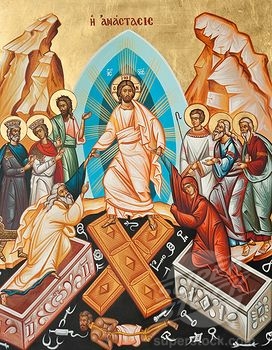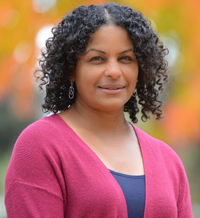For Sunday April 21, 2019
Lectionary Readings (Revised Common Lectionary, Year C)
Isaiah 65:17-25
Psalm 118:1-2, 14-24
1 Corinthians 15:19-26
John 20:1-18
I spent last weekend at “Why Christian 2019,” a conference hosted by Lutheran minister, Nadia Bolz Weber, and post-evangelical writer, Rachel Held Evans. Along with hundreds of other Christians from around the country, I sat in the majestic Grace Cathedral in San Francisco, and listened as speaker after speaker — pastors, journalists, bloggers, parents, poets, activists, and seminarians — testified about their faith. “Why Christian?” was the question they attempted to answer in their moving and often pain-filled narratives. Why, amidst all the challenges and disappointments of American life in 2019, the historic and contemporary failures of the Church, the faith-shaking traumas of their own pasts, do they still have skin in the game?
I heard the story of a priest who crossed the Mexican border in the dead of night at the age of seven, and heard Jesus’s consoling voice during her long, terrifying journey. I listened to a transgender man who grew up poor, and experienced his “first communion” when his grandmother invited him to open her refrigerator and eat freely for the first time in his life. I cried at the story of an African American artist who mourned her way to God after the sudden death of her newborn daughter. And I cried again as an Asian American seminarian talked about wrestling with his faith after being raped as a teenager.
If I went to the conference expecting An Answer — a single, coherent, and conclusive answer to the question, “Why Christian?” I didn’t hear it. What I heard instead are variations on a theme — the theme of hope in the midst of struggle. As in: here is what happened when the pain, trauma, loss, and disappointment of my life bumped up against the inexplicable love of God. Here’s what it felt like when mortality’s “no” collided with divinity’s “yes.” Let me tell you what I saw, heard, smelled, and tasted when the specific death I thought would end me — the death of a child, a relationship, a dream, a belief, an expectation — encountered resurrection. Here’s the story of what happened when I saw the Lord.
| |
This week, the Church celebrates Easter, the highpoint of our liturgical year. With trumpets, Easter lilies, choirs, and “Alleluia” banners, we proclaim the great triumph of Christ’s rising from the dead. The wilderness of Lent is behind us. The tomb is empty and a bright, new day has dawned. “He is Risen! He is Risen, indeed!”
I won’t lie: I LOVE Easter. I love the communal joy and celebration of Easter morning services. I love the music, the vestments, the crowds, and the lights. I love the triumphant and public acclamation of Jesus’s historic and miraculous rising.
But as I sit this week with the Gospel accounts of the resurrection, what I notice is something quieter and more mysterious than the full-on jubiliation I experience at church. I am drawn to what Frederick Buechner calls “the darkness of the resurrection itself, that morning when it was hard to be sure what you were seeing.” Though the past two thousand years have honed and codifed our Easter acclamations, what we know from the Gospels is that the original disciples stumbled around in the half-light on that third day after Jesus’s crucifixion, confused and afraid. Was it an angel, sitting in that unlit tomb? Were those shadows in the corner really grave clothes? That quiet stranger lingering outside — was he a gardener? Or someone else? Why did he look vaguely familiar?
“Early in the morning, while it was still dark….” That’s where Easter really begins. It begins in darkness. It begins with fear, bewilderment, pain, and a profound loss of certainty. The creeds and clarifications we cherish nowadays came later. What came first were many variations on the same theme I heard at the conference: hope in the midst of struggle. As in: here’s what happens when ordinary people brush up against an extraordinary God. Here’s what it looks like when broken, hungry humanity encounters a bizarre and inexplicable Love in the half-light of dawn.
When I was growing up, the key Easter fact to proclaim was that Jesus rose — physically, bodily, literally — from the dead. As long as I believed in the historicity of the resurrection, I was safe. Later, as an adult, I encountered other versions of the Easter narrative. The resurrection was a metaphor in these versions — not a literal, historical fact, but a potent symbol of transformation, renewal, and rebirth. Whether or not Jesus physically rose again didn’t matter — his friends and followers experienced his continued presence, and that was enough.
| |
The fact is, the resurrection happened in total darkness. Sometime in the predawn hours of that Sunday morning, a great mystery transpired in secret. No sunlight illuminated the event. No human being witnessed it. And even now, two thousand years later, no human narrative can contain it. It exceeds all of our attempts to pin it down, because it’s a mystery known only to God. Whatever the resurrection was and is, its fullness lies in holy darkness, shielded from our eyes. All we can know is that somehow, in an ancient tomb on a starry night, God worked in secret to bring life out of death. Somehow, from the heart of loss and misery, God enacted salvation.
In our Gospel story, Mary Magdalene sees Jesus first because she chooses to remain in the darkness. Peter and the beloved disciple leave when they see the empty tomb, but Mary stays, bewildered and bereft. As Nadia Bolz Weber puts it, she “remains present to what is real, to what is actually happening.” She does so even when what is real feels unbearable.
In my own life, I am finding it increasingly true that clarity, hope, and healing come when I am willing to linger in hard and barren places, places where the usual platitudes fall flat, and all easy answers prove inadequate. Jesus comes in the darkness, and sometimes it takes a long time to recognize him. He doesn’t look the way I expect him to look. He doesn’t let me cling to my old ideas. He disappears again just as I grab hold of him. But he comes, he calls my name, and in that instant, I recognize both myself and him.
In a beautiful essay on the resurrection, theologian and writer Chris Barnes reminds us of what actually matters during Holy Week: “The question that Easter asks of us is not, ‘Do we believe in the doctrine of the resurrection?’ Frankly, that is not particularly hard. What the Gospels ask is not, ‘Do you believe?’ but ‘Have you encountered the risen Christ?’”
What I see in the resurrection narratives are individual people having profoundly individual encounters with Christ. The encounters don’t look identical. When Peter sees the empty tomb, he runs away. When the beloved disciple sees it, he believes without comprehension. When Mary sees it, she weeps and waits for more.
 |
In other words, we come to the empty tomb as ourselves, for good or for ill. We don't shed our baggage ahead of time; it barges in with us and shapes our perceptions and conclusions. What matters, then, is encountering the risen Jesus in the particulars of our own messy lives. What matters is finding in the empty tomb the hope we need for our own struggles, losses, traumas, and disappointments. Whatever universal claims we make as Christians must begin in the rich, fertile ground of our own hearts, our own stories. Whatever acclamations we cry out on Easter Sunday must begin with a willingness to linger in the garden, desolate and alone, listening for the sounds of our own names, spoken in love. For our testimonies to ring true, they must originate in radical, intimate encounter. The question is not, “Why should people in general believe?” but rather, “Why do you believe? How has the risen Christ revealed himself to you?”
This type of witness isn’t automatic or easy. It requires risk — the risk of hanging on to hope when all else fails. The risk of sitting in the dark after everyone else runs away. The risk of turning towards the one who calls our name, and recognizing him for the savior he is. Often, it’s only in retrospect, only as I look back at the “gravesides” of my life, that I see my salvation. Poet R.S. Thomas describes the process this way in his poem, “The Answer”: There have been times/when, after long on my knees/ in a cold chancel, a stone has rolled/from my mind, and I have looked/in and seen the old questions lie/ folded and in a place/by themselves, like the piled/graveclothes of love’s risen body.”
This Easter, may the Christ who rose in the darkness lead us into new life, new light, and new hope. May we know him in the half-lit places, the shadowy places, the hard places. May we dare to linger at the tomb until he calls our names and sends us forth to share his good news with the world. And when we are asked, “Why Christian?” may our answers be honest and humble, earned and true. May they witness to hope and struggle, braided together. Happy Easter. Christ is risen. He is risen indeed.
Image credits: (1) Wikimedia.org; (2) Athineon.com; and (3) Turtle Rock.





